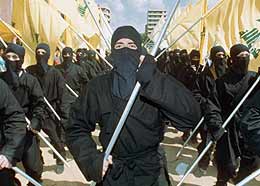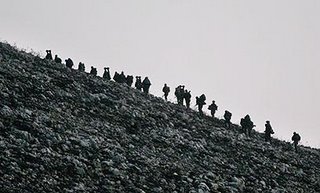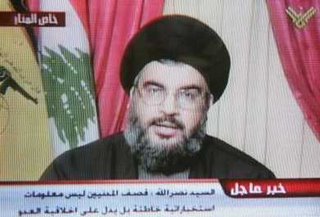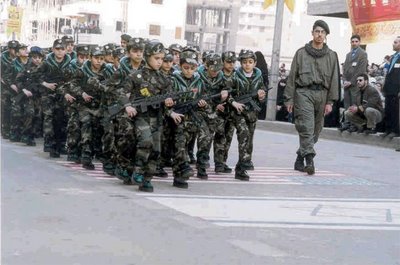UN-Compromising Hizb'allah

'Arguably, the best guerrilla force in the world'
Intelligence experts attribute Hizballah's resilience to zeal, secrecy and assymetrical organization. Israel has never been able to get the upper hand in the intelligence war with Hizballah. Hizballah's military wing, al-Moqawama al-Islamia (Islamic Resistance), is not easily penetrated by outsiders, but has had great success in intelligence operations against Israel. Nearly the entire Shiite population of south Lebanon acts as eyes and ears for the fighters, so it is little surprise that Israel initially concentrated on eliminating regional communications systems and forcing the local population from their homes in the border region.
The Home Base
Shiites comprise about 40% of Lebanon's 4 million inhabitants. Because Hizballah was entrenched in friendly Shiite-inhabited villages and underground bunkers constructed in secret over several years, a withering Israeli air campaign and a tank-led ground assault were unable to establish full control over a border strip and maintain it clear of Hizballah guerrillas. Note that Sunni, Shia from the Amal movement, PLO operatives and leftist groups also, faced the Iraelis in the southern region under the leadership of Hizballah.
 The Means
The MeansMost of the antitank missiles, Israeli officers noted, could be dragged out of caches and quickly fired with two or three-man launching teams at distances of 3,200 yards or more from their targets. One of the most effective was the Russian-designed Sagger 2, a wire-guided missile with a range of 550 to 3,200 yards. Some antitank missiles also can be used to attack helicopters, which has limited the military's use of choppers in rescues and other operations.
In one hidden bunker, Israeli soldiers discovered night-vision camera equipment connected to computers that fed coordinates of targets to the Sagger 2 missile, according to Israeli military officials who described the details from photographs they said soldiers took inside the bunker.
 In a recent statement, Hizballah's armed wing, al-Moqawama al-Islamia, described Israel's main battle-tank, the Merkava-4, as "a toy for the rockets of the resistance," (al-Manar TV, August 11.) Hizballah's anti-tank weapons consist of a variety of wire-guided missiles (usually of Russian design and manufactured and/or supplied by Iran and Syria) and rocket-propelled grenade launchers, (RPGs.) -- most strikingly, destructive against the Israeli advanced armor plated Merkava-4 battle tanks was an improved version of the RPG-29.
In a recent statement, Hizballah's armed wing, al-Moqawama al-Islamia, described Israel's main battle-tank, the Merkava-4, as "a toy for the rockets of the resistance," (al-Manar TV, August 11.) Hizballah's anti-tank weapons consist of a variety of wire-guided missiles (usually of Russian design and manufactured and/or supplied by Iran and Syria) and rocket-propelled grenade launchers, (RPGs.) -- most strikingly, destructive against the Israeli advanced armor plated Merkava-4 battle tanks was an improved version of the RPG-29.The weapon used in an attack against an Israeli warship that killed four commandos was identified by the Israeli military as an Iranian-made C-802 Noor radar-guided land-to-sea missile (range 95 km). [Hizballah claims to have hit 3 Israeli ships during the war] Most other missiles used by Hizballah are Iranian-made, including the Raad 2 and 3 models (used against Haifa), the Fajr-3 and 5 and, allegedly, the Zelzal-2, with a range of 200 km.
http://www.jamestown.org/terrorism/news/article.php?search=1&articleid=2370089
 The Israeli Intelligence Failure
The Israeli Intelligence FailureIsrael invaded Lebanon in 1978 and in 1982 in order to liquidate the Palestine Liberation Organization during the 1980s. In that war, Israeli forces punched straight northward and reached Beirut in a few days with only minor resistance. Israeli officers thought they could duplicate that performance against Hizballah with similar impunity.
This overestimation of Israeli capabilities and underestimation of Hizballah resources are marked failures of Israeli intelligence and bring into question the veracity of the claim that Hizballah has been infiltrated.
One reason for the sharp difference from previous Israeli invasions is that Israeli intelligence had much less detail on Hizballah forces, tactics and equipment than it had on the PLO, which was infiltrated by a network of spies, said Trabulsi, a political science professor at Lebanese American University. "Hizballah is not penetrated at all," he said.
A military analyst notes throughout the sweep of fighting over the last month -- when Israel on several occasions said it controlled the terrain, only to continue fighting in the same border villages -- suggested intelligence had not provided an adequate appreciation of the battlefield.
"I think it's no secret that the Israeli military didn't have the intelligence on this," said Richard Straus, who publishes the Middle East Policy Survey newsletter in Washington. "They didn't know what Hizballah had, how it had built up, what it was capable of."Hizballah's resistance to penetration by Israeli intelligence was part of a culture of secrecy extreme even by the standards of underground guerrilla forces. The code fit with a tendency toward secrecy in the Shiite stream of Islam, called faqih. It also fit with a sense of solidarity against others that Lebanese Shiites have been imbued with since the beginning of their emergence as a political force in the mid-1970s, when their first organization was called the Movement of the Deprived.
One young Lebanese doctor learned that her brother had been a Hizballah fighter for several years only when the movement notified her he had been killed, colleagues said. Similarly, a Lebanese man found out his brother was a senior Hizballah militia officer only when informed of his death; the brother had cloaked occasional trips to Tehran by saying he was trying to start an import-export business.
Even the movement's political leadership was kept in the dark about many military and intelligence activities. Ghaleb Abu-Zeinab, a member of Hizballah's political bureau, said in an interview, for instance, that he was not informed about operations on "the field," Hizballah shorthand for the villages and hillsides across southern Lebanon where the battles raged.
They have a military and intelligence organization totally separated from the political organization.Hizballah's command structure is decentralized, which makes it difficult to eliminate. The military operations are carried out in small cadres, but are often coordinated. Hizballah's choice of communication was the walkie-talkie, because they feared breaches would occur if they used sattelite based or fixed systems of communications.
A dramatic example of the secrecy and careful preparations for conflict with Israel was Hizballah's al-Manar television. The station has kept broadcasting its mix of news and programs from hidden studios throughout the fighting, despite repeated Israeli airstrikes against its buildings, relay towers and antennas across the country. Some Lebanese opined that the broadcasts seemed to include coded messages to Hizballah fighters in southern Lebanon. But as with most things about Hizballah, they were not really sure.
 Sayyed Hassan Nasrallah, the Secretary General of Hizballah, used al-Manar to make a number of speeches rallying his followers and explaining his strategy to Lebanon and the world at large. With his cleric's turban and student's mien, appearing on the screen in pre-taped broadcasts, he was perhaps the biggest secret of all, hunted by Israeli warplanes and spy drones safely, planning in a location about which Lebanese and Israelis alike could only guess.
Sayyed Hassan Nasrallah, the Secretary General of Hizballah, used al-Manar to make a number of speeches rallying his followers and explaining his strategy to Lebanon and the world at large. With his cleric's turban and student's mien, appearing on the screen in pre-taped broadcasts, he was perhaps the biggest secret of all, hunted by Israeli warplanes and spy drones safely, planning in a location about which Lebanese and Israelis alike could only guess. Israeli warplanes attacked Secretary General of Hizballah, Sayyed Hassan Nasrallah's residence and Hizballah's main headquarters in an apparent assassination attempt, and Israel vowed to press its offensive in Lebanon until the Shiite Muslim militant group was destroyed and disarmed. A number of IDF special forces operations into the towns of Balbaek and Tyre, described by some media sources as "daring," only resulted in lackluster kidnappings of a grocer named Hassan Dib Nasrallah and other civilians.
Israeli warplanes attacked Secretary General of Hizballah, Sayyed Hassan Nasrallah's residence and Hizballah's main headquarters in an apparent assassination attempt, and Israel vowed to press its offensive in Lebanon until the Shiite Muslim militant group was destroyed and disarmed. A number of IDF special forces operations into the towns of Balbaek and Tyre, described by some media sources as "daring," only resulted in lackluster kidnappings of a grocer named Hassan Dib Nasrallah and other civilians.It is expected that Israel would attempt to establish intelligence assets inside Lebanon and Hizballah in particular. The depth or effectiveness of which however, is not substantiated by the operational situation that unfolded during and before the war.
For instance, according to JPost.com, Lebanese security and Hizballah intelligence units uncovered what they claimed was a "prominent" Israeli spy ring that had been active in Lebanon since 1990, the Lebanese As-Safir newspaper reported before the war on Wednesday, June 14, 2006. The Lebanese intelligence sources said it had dismantled a network used by the Israeli spy agency Mossad, to carry out attacks in Lebanon, mainly against Hizballah and pro-Syrian Palestinian groups. The ensuing arrests amounted to over 80 Israeli operatives being jailed and interrrogated, which significantly, degraded Israeli intelligence in Lebanon. Subsequently, confesssions made by the saboteurs informed Hizballah of an impending attack by Israel early in the fall.
sources:http://www.lebaneselobby.org/News__index/news%202006/06%2013%2006%20Lebanon%20says%20Israeli%20spy%20cell%20exposed.htmlThe Mossad and Israeli military intelligence, previously stellar organizations in the Middle East and elsewhere, were caught completely offguard and with their pants down regarding Hizballah's latest capabilities. Why was this a guessing game? Why wasn't the intelligence "in" on Hizballah? You mean to tell us that no such intelligence agents have been able to infiltrate Hizballah and sit in on their strategy meetings? No Mossad agent or any other IDF military agent has been able to penetrate them and really, have a definitive analysis as to their motives, their short and long term goals? You mean to tell us that it was down to bloggers' brigades and posters to analyze and propagate Hizballah tactics? These ostensibly, are some of the poignant questions being asked by citizens and the defense establishment of Israel in the aftermath of Hizballah's valiance.
http://www.middle-east-online.com/english/?id=16721
 This is why they fight and must continue to resist to guard against an encroaching Israeli State ever more thirsty for land, resources and power! Hizballah and such grassroots movements certainly, have to wedge a niche for themselves in the face of the hegemons. More power to them and may justice and peace reign in the age old confrontation with oppression.
This is why they fight and must continue to resist to guard against an encroaching Israeli State ever more thirsty for land, resources and power! Hizballah and such grassroots movements certainly, have to wedge a niche for themselves in the face of the hegemons. More power to them and may justice and peace reign in the age old confrontation with oppression.Crux of the matter is, Mossad and IDF intelligence were unable to infiltrate, analyze and subdue Hizballah and Lebanese resilience. These deficiencies along with operational failures on the battlefield (to locate and assassinate Sheikh Nasrallah and other Hizballah leaders after repeated attempts and dissuade the resolve of the polutation) eventhough, razing Lebanese civil infrastucture, wounding many thousands, killing over a thousand civilians and turning over a million into refugees ultimately, lead Israel to realize the futility of the adventure, leaving Hizballah mostly, intact and UN-compromising.


0 Comments:
Post a Comment
<< Home